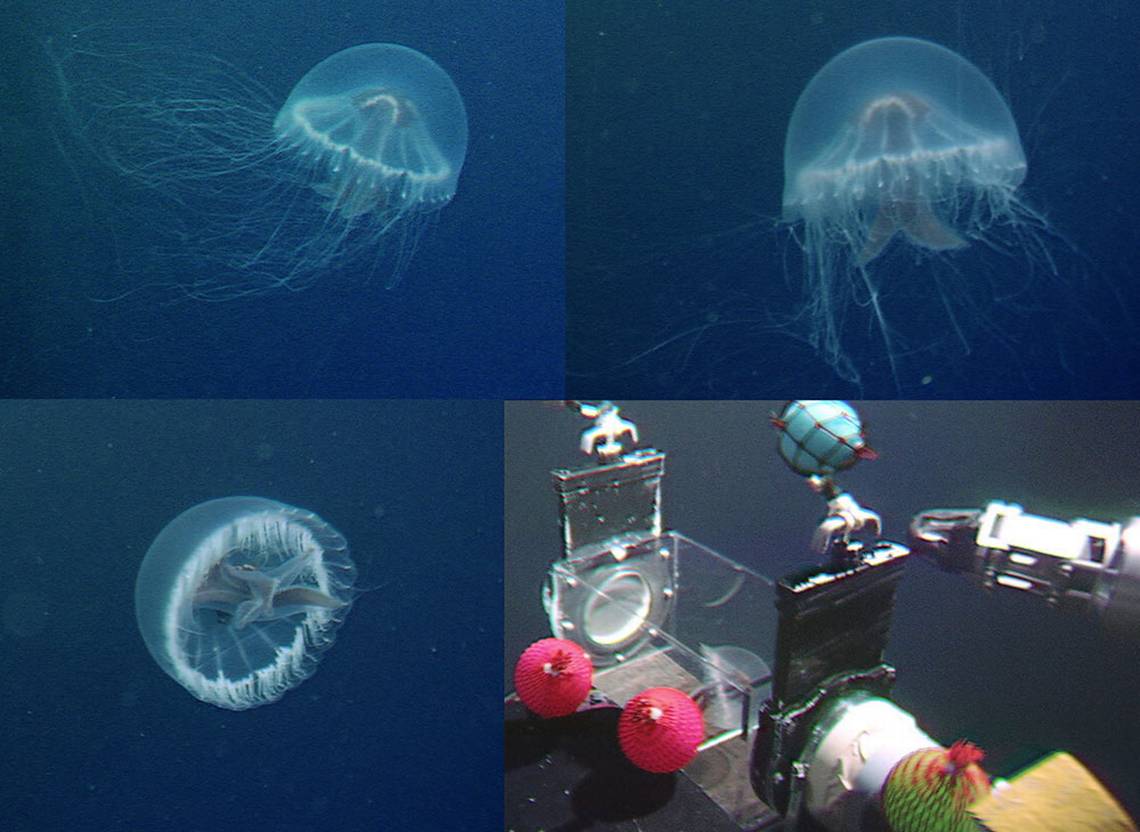A Japanese and Brazilian team of scientists found a funky new jellyfish with a distinguishing mark. The St. George’s cross medusa (Santjordia pagesi or S. pagesi) is a new medusa jellyfish species that was found about 2,664 feet deep in the Pacific Ocean. It lives in a deep-sea volcanic structure called the Sumisu Caldera. This hot, hydrothermally active caldera is about six miles across and is located off the coast of Japan’s Ogasawara Islands, about 285 miles south of the capital city of Tokyo. The findings are described in a study published in November the journal Zootaxa.
[Related: Even without brains, jellyfish learn from their mistakes.]
Protecting its snacks–with a shield and 240 tentacles
The St. George’s Cross medusa is considered fairly large for a jellyfish, at about four inches wide and three inches long. It also boasts roughly 240 tentacles. It gets its name from a cross shape on its body when viewed from above that resembles the red Cross of St. George on the English flag.
It is a type of jellyfish called a medusa (or the plural form, medusae), which are free-swimming jellyfish that are shaped like an umbrella and have a reduced stalk.
“The species is very different from all the deep-sea medusae discovered to date. It’s relatively small, whereas others in this kind of environment are much larger. The bright red coloring of its stomach probably has to do with capturing food,” André Morandini, a study co-author and biologist at the University of São Paulo in Brazil, said in a statement.
Like all jellyfish, S. pagesi is transparent. It also eats other bioluminescent organisms in the deep sea that give off light. The team believes that its bright red stomach acts like a shield to hide its prey. This way, other organisms can’t see its meal after it has swallowed it.
A rare find
While new species are discovered and described all the time, this one was particularly rare. It was so difficult for the team to collect, that the findings are based on one single specimen. However, the team reportedly saw another S. pagesi nearby and expect future surveys to show more members of the group.

The specimen in the study was captured back in 2002 by the Remotely Operated Vehicle (ROV) Hyperdolphin. The Sumisu Caldera can only be accessed through an ROV since it is so deep . Scientists didn’t see any other specimens until 2020. An ROV filmed, but didn’t collect, another jellyfish of the same species.
[Related: These fingernail-sized jellyfish can regenerate tentacles—but how?]
“We opted to publish the description and call attention to the species that are present at the site, which has a substrate rich in minerals and the potential to be commercially developed. Unfortunately, research can’t be conducted in such places without partners who have interests of this kind,” Morandini said.
‘Arsenal of venoms’
S. pagesi belongs to a new subfamily named Santjordiinae. It has small sensory structures called rhopalia on underneath and on the edges of its umbrella, which makes it unique among jellyfish in the order Semaeostomeae. This is the order that more common species like moon jellyfish belong to. The team believes it could eventually fit within Semaeostomeae when they can collect more species. For now, it remains in Ulmaridae, the broader jellyfish family.
Since it is so different among jellyfish, the authors believe that it potentially has an “arsenal of venoms” that are unlike those previously discovered in jellyfish. The Indo-Pacific box jellyfish releases a venom that makes the heart contract and Australian box jellyfish can release this venom from thick tentacles that grow up to 10 feet long.
“Who knows? Maybe it holds secrets more valuable than all the mineral wealth that could be extracted from that place. All this with the advantage of keeping the species and the site intact,” said Morandini.





